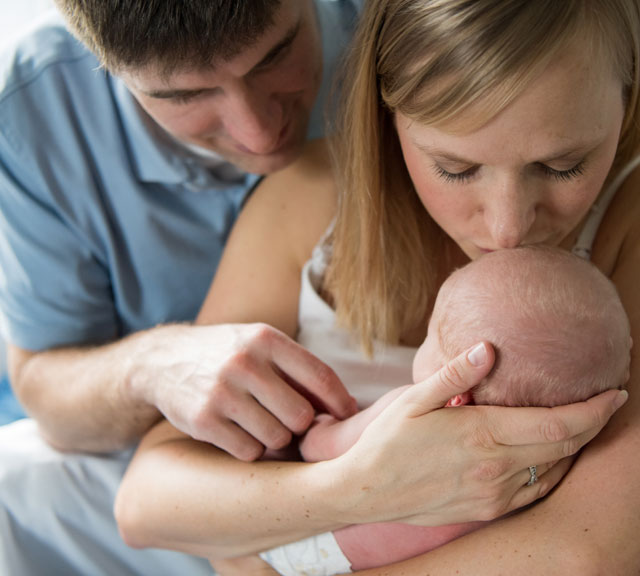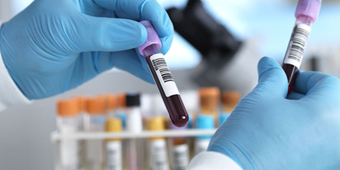Heart Of the Matter: Most Common Birth Defect

Answer a few questions and we'll provide you with a list of primary care providers that best fit your needs.
Of course you want your newborn to be perfect! However, it is possible for babies to be born with an abnormality in the heart. A congenital heart defect develops in a baby’s heart during pregnancy. “Congenital” means present at birth
Congenital heart defects range from mild to severe. Some are so minor they have no symptoms, and a child could live for years before the condition is detected. Others are complex and life-threatening.
Congenital heart defects affect how a baby’s heart functions. Defects may alter the structure of the heart or how blood flows from the heart through the body. Heart defects may lead to related complications elsewhere in the heart or other parts of the body, such as the lungs.
About 1 percent of babies (40,000) are born with a congenital heart defect in the United States each year, according to the March of Dimes. This makes heart defects the most common type of birth defect.
About 1 percent of babies (40,000) are born with a congenital heart defect in the United States each year, according to the March of Dimes.
Causes Of Congenital Heart Defects
Congenital heart defects develop during the early weeks of pregnancy. With a defect, a certain structure of the heart does not fully develop. Examples include a hole that doesn’t fully close in the developing heart, an artery that is too narrow, or a blocked heart valve.
The exact cause of such defects is unknown. But factors that may play a role include:
- Changes in genes or chromosomes
- Certain medications a woman takes during pregnancy
- Smoking or drinking alcohol during pregnancy
- The mother’s health. For example, preexisting diabetes and obesity have been linked to heart defects in babies.
Types Of Congenital Heart Defects
The American Heart Association recognizes at least 18 distinct types of congenital heart defects.
The most common of these defects affect the following parts of the heart:
- Septum. This is the wall that divides the right and left sides of the heart. A common problem is a hole in the septum, known as an atrial septal defect (ASD) or ventricular septal defect (VSD), depending on where the hole is.
- Aorta. The aorta is a large artery. It carries blood from the heart to the rest of the body. When part of the aorta is too narrow, this condition is called coarctation of the aorta.
- Heart valves. The valves of the heart control the blood flow into and out of the heart. The heart valves can be blocked, not close properly, or be too narrow so that blood doesn’t flow as it should.
Sometimes a baby will have more than one of these problems at the same time.
Seven heart defects are considered to be the most severe conditions. Babies with these defects need treatment soon after birth. These are referred to as critical congenital heart disease (CCHD) and include:
- Hypoplastic left heart syndrome (HLHS)

- Pulmonary atresia (PA)
- Tetralogy of Fallot (TOF)
- Total anomalous pulmonary venous return (TAPV or TAPVR)
- Transposition of the great arteries (TGA)
- Tricuspid atresia (TA)
- Truncus arteriosus
Diagnosing Congenital Heart Defects
Some heart defects are diagnosed before birth. Others are not found until after birth, later in childhood, or even in adulthood. Someone with a minor heart defect might live symptom-free for many years before the condition is diagnosed.
Even if no heart problem is detected before birth, your baby will be screened after 24 hours of age with a quick, painless test for heart problems. It’s a pulse oximetry screening for congenital heart defects.
When symptoms are noticed, a doctor will perform a physical exam to begin looking for underlying problems. Tests may be used to help make a diagnosis, such as an echocardiogram (also called an echo or cardiac ultrasound), electrocardiogram (EKG or ECG), chest X-ray, pulse oximetry, and cardiac catheterization.
Treating Congenital Heart Defects
If your child has a congenital heart defect, you will be referred to a pediatric cardiologist who will help care for your child.
Several options are available for treating heart defects. Treatment is based on each baby’s individual needs, as well as the wishes of the family. Your care team may discuss the following treatment options with you:
- Prenatal intervention. Some conditions can be treated before the baby is born. In some cases, surgery while the baby is still in the womb is a possibility. This requires a highly specialized fetal care team.
- Surgery. Your baby might need one or more surgeries immediately after birth or as she grows. Heart transplant is a possibility for some children.
- Cardiac catheterization. In this procedure, a thin tube is inserted into the heart through which a doctor performs certain heart repairs. This procedure offers quicker recovery times and is less invasive than traditional surgery.
- Medications. Some babies will require medications to treat their heart defect or a combination of surgery, cardiac catheterization, and medication.
- Monitoring. Some heart defects resolve on their own. For example, a hole in the heart may close as your child grows. With conditions like this, it may be best to take a “watch and wait” approach, to see how the defect progresses over time.
Because children with heart defects are living longer than ever before, some cardiologists now specialize in caring for adults with congenital heart disease (ACHD). They have specific knowledge and training about congenital heart defects, which differ from heart disease that develops later in life. Your child may benefit from seeking the care of one of these specialists as he grows into adulthood.
Answer a few questions and we'll provide you with a list of primary care providers that best fit your needs.
Source: American Heart Association; March of Dimes; Centers for Disease Control and Prevention; Stanford Children’s Health




